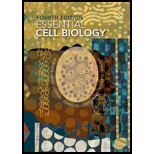
Concept explainers
A.
To estimate: The length of DNA strands between the replication forks in the given micrograph and the time taken until the forks 4 and 5, and forks 7 and 8 will collide with each other.
Introduction: DNA is the blueprint of life and contains genetic information. Replication of DNA is semi-conservative. It begins at certain locations on the DNA known as origins of replication having a replication fork. The two replication forks move in opposite directions from origin and separate the two DNA strands.
A.
Explanation of Solution
Refer to Fig. 6-9, “The two replication forks move away in opposite directions at each replication origin” in the textbook. The micrograph shows the scale bar for measurement of DNA strand undergoing replication. Drawing 2 shows the replication process in a fly where replication forks form. As per the scale bar, the distance between replication forks 4 and 5 is approximately 0.28 µm, that is, 280 nm. It corresponds to 824 nucleotides (280/0.34), since the distance between two bases is 0.34 nm. The replication forks in eukaryotes move at about 100 nucleotides per second. Thus, the time taken for forks 4 and 5 to collide would be about 8 seconds. As shown in the drawing, replication forks 7 and 8 would never collide as they move away from each other.
B.
To evaluate: The fraction of genome of fly shown in the given micrograph.
Introduction: DNA is the blueprint of life and contains genetic information. Replication of DNA is semi-conservative. It begins at certain locations on the DNA known as origins of replication having a replication fork. The two replication forks move in opposite directions from origin and separate the two DNA strands.
B.
Explanation of Solution
The above-mentioned micrograph shown in Fig. 6-9 represents that the length of DNA is about 1.5 µm (1500). It corresponds to 4400 nucleotides (1500/0.34), since the distance between two bases is 0.34 nm. If the fly genome has 1.8×108
The fraction of fly genome shown in the micrograph is 0.002%.
Want to see more full solutions like this?
Chapter 6 Solutions
Essential Cell Biology
 Human Anatomy & Physiology (11th Edition)BiologyISBN:9780134580999Author:Elaine N. Marieb, Katja N. HoehnPublisher:PEARSON
Human Anatomy & Physiology (11th Edition)BiologyISBN:9780134580999Author:Elaine N. Marieb, Katja N. HoehnPublisher:PEARSON Biology 2eBiologyISBN:9781947172517Author:Matthew Douglas, Jung Choi, Mary Ann ClarkPublisher:OpenStax
Biology 2eBiologyISBN:9781947172517Author:Matthew Douglas, Jung Choi, Mary Ann ClarkPublisher:OpenStax Anatomy & PhysiologyBiologyISBN:9781259398629Author:McKinley, Michael P., O'loughlin, Valerie Dean, Bidle, Theresa StouterPublisher:Mcgraw Hill Education,
Anatomy & PhysiologyBiologyISBN:9781259398629Author:McKinley, Michael P., O'loughlin, Valerie Dean, Bidle, Theresa StouterPublisher:Mcgraw Hill Education, Molecular Biology of the Cell (Sixth Edition)BiologyISBN:9780815344322Author:Bruce Alberts, Alexander D. Johnson, Julian Lewis, David Morgan, Martin Raff, Keith Roberts, Peter WalterPublisher:W. W. Norton & Company
Molecular Biology of the Cell (Sixth Edition)BiologyISBN:9780815344322Author:Bruce Alberts, Alexander D. Johnson, Julian Lewis, David Morgan, Martin Raff, Keith Roberts, Peter WalterPublisher:W. W. Norton & Company Laboratory Manual For Human Anatomy & PhysiologyBiologyISBN:9781260159363Author:Martin, Terry R., Prentice-craver, CynthiaPublisher:McGraw-Hill Publishing Co.
Laboratory Manual For Human Anatomy & PhysiologyBiologyISBN:9781260159363Author:Martin, Terry R., Prentice-craver, CynthiaPublisher:McGraw-Hill Publishing Co. Inquiry Into Life (16th Edition)BiologyISBN:9781260231700Author:Sylvia S. Mader, Michael WindelspechtPublisher:McGraw Hill Education
Inquiry Into Life (16th Edition)BiologyISBN:9781260231700Author:Sylvia S. Mader, Michael WindelspechtPublisher:McGraw Hill Education





